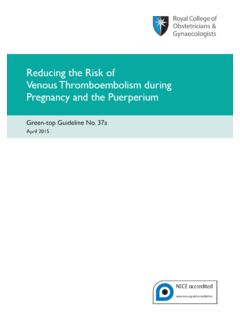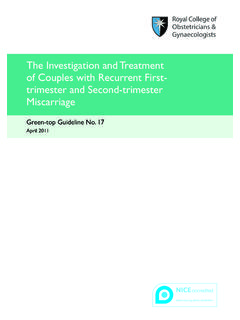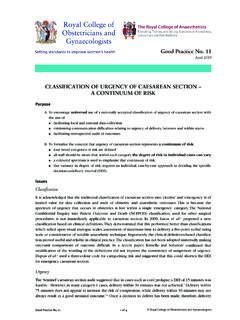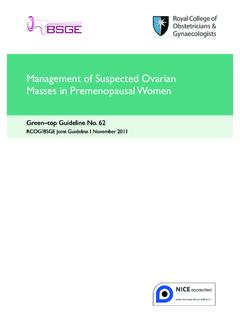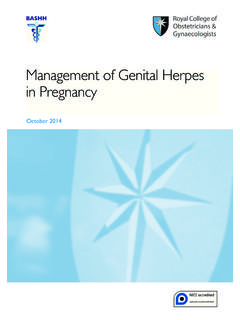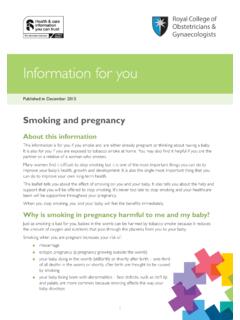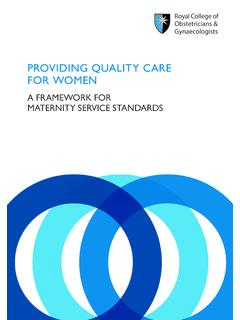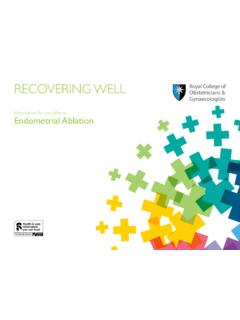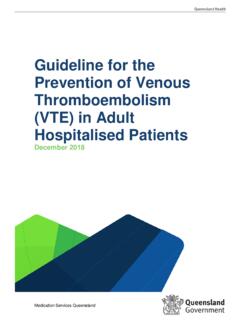Transcription of Thromboembolic Disease in Pregnancy and the Puerperium ...
1 Thromboembolic Disease in Pregnancy and the Puerperium : Acute Management Green-top Guideline No. 37b April 2015. Thromboembolic Disease in Pregnancy and the Puerperium : Acute Management This is the third edition of this guideline. The first edition was published in April 2001 under the same title (numbered Green-top Guideline No. 28) and the second edition was published in February 2007. and reviewed in 2010. Thromboprophylaxis during Pregnancy and the Puerperium is addressed in Green-top Guideline No. 37a. Executive summary of recommendations Diagnosis of acute venous thromboembolism (VTE).
2 How is acute VTE diagnosed in Pregnancy ? Any woman with symptoms and/or signs suggestive of VTE should have objective testing performed expeditiously and treatment with low-molecular-weight heparin (LMWH) given (see section 6). C. until the diagnosis is excluded by objective testing, unless treatment is strongly contraindicated. Individual hospitals should have an agreed protocol for the objective diagnosis of suspected VTE. during Pregnancy . This may recommend the involvement of obstetricians, radiologists, physicians P. and haematologists.
3 What investigations are needed for the diagnosis of an acute DVT? Compression duplex ultrasound should be undertaken where there is clinical suspicion of DVT. B. If ultrasound is negative and there is a low level of clinical suspicion, anticoagulant treatment can be discontinued. If ultrasound is negative and a high level of clinical suspicion exists, anticoagulant C. treatment should be discontinued but the ultrasound should be repeated on days 3 and 7. [New 2015]. What investigations are needed for the diagnosis of an acute pulmonary embolism (PE)?
4 Women presenting with symptoms and signs of an acute PE should have an electrocardiogram (ECG) and a chest X-ray (CXR) performed. [New 2015]. C. In women with suspected PE who also have symptoms and signs of DVT, compression duplex ultrasound should be performed. If compression ultrasonography confirms the presence of DVT, C. no further investigation is necessary and treatment for VTE should continue. [New 2015]. In women with suspected PE without symptoms and signs of DVT, a ventilation/perfusion (V/Q) lung scan or a computerised tomography pulmonary angiogram (CTPA) should be performed.
5 [New 2015]. C. When the chest X-ray is abnormal and there is a clinical suspicion of PE, CTPA should be performed in preference to a V/Q scan. [New 2015]. D. Alternative or repeat testing should be carried out where V/Q scan or CTPA is normal but the clinical suspicion of PE remains. Anticoagulant treatment should be continued until PE is definitively C. excluded. Women with suspected PE should be advised that, compared with CTPA, V/Q scanning may carry a slightly increased risk of childhood cancer but is associated with a lower risk of maternal breast D.
6 Cancer; in both situations, the absolute risk is very small. [New 2015]. RCOG Green-top Guideline No. 37b 2 of 32 Royal College of Obstetricians and Gynaecologists Where feasible, women should be involved in the decision to undergo CTPA or V/Q scanning. Ideally, informed consent should be obtained before these tests are undertaken. P. Should D-dimer testing be performed prior to objective diagnosis? D-dimer testing should not be performed in the investigation of acute VTE in Pregnancy . D. What is the role of pretest probability assessment?
7 Clinicians should be aware that, at present, there is no evidence to support the use of pretest probability assessment in the management of acute VTE in Pregnancy . [New 2015]. C. Baseline blood investigations What baseline blood investigations should be performed before initiating anticoagulant therapy? Before anticoagulant therapy is commenced, blood should be taken for a full blood count, coagulation screen, urea and electrolytes, and liver function tests. D. Performing a thrombophilia screen prior to therapy is not recommended.
8 B. Initial anticoagulant treatment of VTE in Pregnancy What is the initial treatment of VTE in Pregnancy ? In clinically suspected DVT or PE, treatment with low-molecular-weight heparin (LMWH) should be commenced immediately until the diagnosis is excluded by objective testing, unless treatment is B. strongly contraindicated. What is the therapeutic dose of LMWH in Pregnancy ? LMWH should be given in doses titrated against the woman's booking or early Pregnancy weight. There is insufficient evidence to recommend whether the dose of LMWH should be given once daily C.
9 Or in two divided doses. [New 2015]. There should be clear local guidelines for the dosage of LMWH to be used. P. Should blood tests be performed to monitor heparin therapy in Pregnancy ? Routine measurement of peak anti -Xa activity for patients on LMWH for treatment of acute VTE. in Pregnancy or postpartum is not recommended except in women at extremes of body weight C. (less than 50 kg and 90 kg or more) or with other complicating factors (for example, with renal impairment or recurrent VTE). Routine platelet count monitoring should not be carried out.
10 D. Obstetric patients who are postoperative and receiving unfractionated heparin should have platelet count monitoring performed every 2 3 days from days 4 to 14 or until heparin is stopped. D. [New 2015]. How should massive life-threatening PE in Pregnancy and the Puerperium be managed? Collapsed, shocked women who are pregnant or in the Puerperium should be assessed by a team of experienced clinicians including the on-call consultant obstetrician. P. RCOG Green-top Guideline No. 37b 3 of 32 Royal College of Obstetricians and Gynaecologists Women should be managed on an individual basis regarding: intravenous unfractionated heparin, thrombolytic therapy or thoracotomy and surgical embolectomy.
